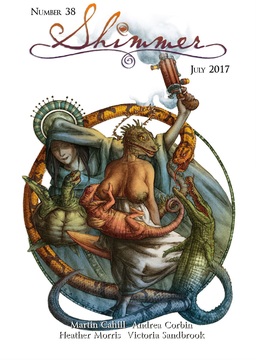“Salamander Six-Guns” by Martin Cahill
Reviewed by Stephanie Wexler
In “Salamander Six-Guns” by Martin Cahill, Copper lives on the frontier called Sunblooders Stand. Kind of reminds me of the Alamo except instead of a human army there are lizards from another world bent on taking over everyone and everything. During a lizard raid Copper and the townspeople called “sonblooders” are pressed to keep hold of their land and their lives when a stranger swoops in to their aid. Copper immediately doesn’t like the man. Yet the townspeople are enchanted by his six-guns, crazy stories and start calling him Mayer. Copper is even more suspicious at how easily Mayer fits in but forces himself to give him a chance. Mayer is a good fighter. Even though Copper feels there is something Mayer is still hiding, he falls for him and then the bubble bursts. The “scaled things” that Copper and the sunblooder’s work to wipe out had taken Mayer’s friend and Mayer was bent on finding him. I’m not a big fan of the wild west mythos. Yet, Cahill blended a landscape so dry, run down and full of spirit even when I ran into the cliché wild west dialogue it was easy to overlook. Tragic, heroic, and built around aliens bent on twisting the human landscape, be prepared to jump into an exotic yet satisfying ride.
In “Itself at the Heart of Things” by Andrea Corbin, Paris is being invaded by Szemurians. Supposedly, the Szemurians have lived under the radar and for little reason announced their arrival through dreams. Other than looking human, but not quite acting human, Corbin uses the Benoits to personify the invaders. The Benoits, a happily married couple, before the invasion deal with their world crashing down around with clashing attitudes. Mr. Benoit is busy boarding up the house and preparing to evacuate to a bomb shelter, while his wife decides to literally dissemble her body. If this isn’t weird enough, Mrs. Benoit reflects on when she got married and when all the fuss started with the arrival of the aliens. All through this Mr. Benoit is getting more pissed and takes matters into his own hands (picking up his wife’s pieces and fleeing). Yet Mrs. Benoit unknowingly has the key that will change their lives. Corbin’s Szemurians are such a benign threat that all the imagery; deconstruction of the house, the empty streets, and Mrs. Benoit’s decision to physically dismantle her body wind-up as an extreme answer to being wiped out of existence. The Benoits do choose life, but could it be any more bizarre than the lives they gave up?
The adage, “Don’t judge a book by its’ cover,” rings true in Heath Morris’s “Maps of Infinity.” Asterion, a revered minotauresque god, is delivered sacrifices of children that he does not have the heart to kill. Having had no contact with his own kind, Asterion relies on what little he absorbed through his mother’s womb and communication with the children. However, with the physical language barriers Asterion is left to his own thoughts and confusing existence. The King’s Ugly Daughter is an abused child for being born a girl. Her mother heaps on the insults that her daughter’s presence has lost them their chance to be royalty. Sick of mixed messages of love and rejection her daughter uses her robust and strong physique to get rid of monsters. She works hard and eventually meets up with Asterion. Their meeting is bathed in fear, blood, misunderstandings and shared lack of mothering. Granted the end is a bit predictable, but no less an important lesson about embracing your differences in yourself and others fostering new possibilities.
Andy is a Truth-runner in “The Moon, the Sun, and the Truth” by Victoria Sandbrook. Unlike her mother, Andy has chosen a profession to carry data that the Dictatorship would rather kill people than have this information broadcast. We never know exactly what the data shows but Dan, Andy’s contact, gives us an impression the Dictatorship is a harsh and controlling world. Yet little is mentioned about what the Dictatorship has done to make life difficult other than Factory work as an unfavorable career. Now, Andy with the data chip in hand, makes her way to the undertaker (the broadcaster) allowing herself some time to think about her last partner and the life they both worked to create even with the added risk of their work. Yet, we are never expected to settle into this vision of domestic bliss. Andy is now racing into town, handing her chip to the undertaker with the Dictatorship’s men hot on her heels. It seems Sandbrook tries to create more tension by leaving out information. Even to the point we have to guess what Dan saw that moved the Dictatorship to eliminate the stolen facts. However, Andy, Dan, and Sonia are rich characters in a distraught world, risking everything to reveal the truth; a mysterious truth so dangerous it is left to the imagination. Is their sacrifice worth giving up everything?
 Shimmer #38, July/August 2017
Shimmer #38, July/August 2017